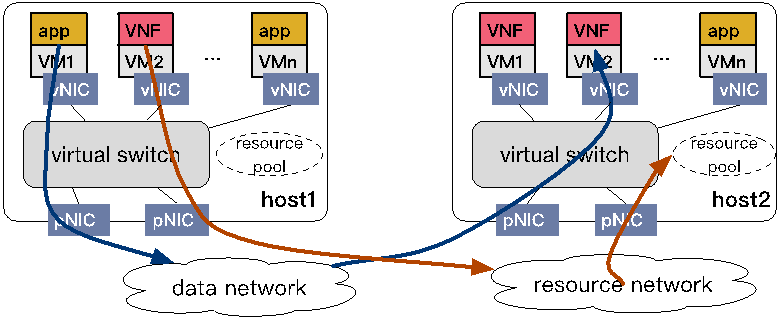Computer Network and Cloud Computing
Date: Jun 09, 2021
Research priorities include Internet architecture, data center network, cloud computing, 5G edge computing, Internet of Things, intelligent network, network big data, etc.
1) Evolvable Network Architecture
The evolvable network architecture incorporates 5G/B5G, IP protocol, SDN/NFV and other baseline technologies to evolve a variety of adaptive characteristics such as deterministic transmission, endogenous security, autonomous operation and efficient management of data communication protocol. This evolvable architecture supports the creation of data message “recipes” based on personal “appetites”, which will be an engine to drive the network communication industry and other related industries.
2) 5G edge Computing Technology and Innovation System
Research priorities include ultra-high-definition video distribution technology based on edge computing, 5G millimeter-wave transmission optimization, distributed cooperative deep learning based on edge computing and transmission optimization in 5G high-speed mobile scene. Tailored applications are developed for different scenarios such as e-Science, high-speed railway communication, ultra-high-definition video service, industrial Internet and Internet of Things. Concerning the effects, the High-Speed Railway Mobile Private Network System developed with China Railway has been tested in Beijing-Shanghai High-Speed Railway with good results. Applications in ultra-high-definition video service, automobile intelligent manufacturing and e-infrastructure for research have received several academic and industrial awards.

Scientific Research Cloud with 5G Edge Cloud Integration
3) SD-WAN Transfer Optimization Technologies and System
Rooted in the strength of SD-WAN for constructing intelligent accelerated overlay network, the team have “cultivated” the SmartCloudWAN, a WAN acceleration system which integrates a variety of network transfer optimization technologies such as new transport protocol and network coding to improve the network transfer efficiency.
4) Low-power IoT Monitoring System
The low-power IoT monitoring system has been widely used in industry. 2184 sensors and 48 edge gateways have been deployed at field stations to achieve real-time online monitoring of temperature, humidity of soil, and water level. The system has supported smart agriculture in various aspects such as the real-time monitoring of soil salinity and animal breeding.
5) Artificial Intelligence for IT Operations (AIOps)
To address challenges posed by software-defined and dynamically changing resources, the team uses AI technologies to facilitate IT operations. System operation data have been collected and analyzed to identify significant events, study the systems and predict future trends at the forefront of data science and machine learning.
6) Packet Computing Model and System
To undertake innovative applications requiring ultra-low latency, high throughput, huge simultaneous connections on information infrastructure, we explore the architecture of networking system based on the novel packet computing model. We argue packet as the basic elementary of the model, while bit in communication and cacheline in computer. The packet computing model abstracts network functions and application computations into the unified packet-granularity processing, which integrates computing, networking, and storage resource into flexible, workload-adaptive, efficient data plane. The team are focusing on theory, algorithm, implementation mechanism and system of the programing model, in-computer networking and in-network computing.

Software packet forwarding on cloud virtual systems
7) Key Mechanisms and Technologies for Cloud Federation System
To establish a federation among large-scale, distributed and heterogeneous cloud systems, the team develop system software and toolsets to support the interoperability of federated services. A prototype has been designed for CSTCloud to achieve authentication and cloud resource integration across organizations in a secure and controllable way. This prototype has integrated science literacy resources of more than 20 service providers, accessed by over one million active users from 8 universities and research institutions.
